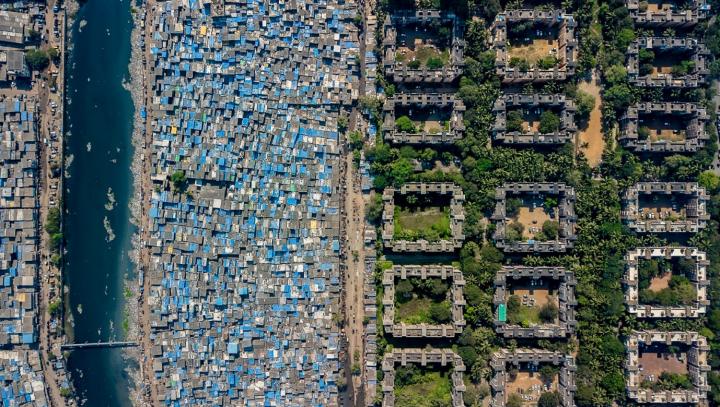
Credit: Unequal Scenes, @johnny_miller_photography
CREDIT MUST BE GIVEN
A new study examines energy inequality for income classes across 86 countries, from highly industrialised to developing ones, revealing extreme disparity in energy footprints, both within nations and globally.
In the first study of its kind, University of Leeds researchers combined European Union and World Bank data to calculate the distribution of energy footprints, as well as what energy-intensive goods and services different income groups tend to spend their money on.
Their study, published today in Nature Energy, shows that energy footprints grow with expenditure, and, as a consequence, are unequally distributed. Among all the countries and income classes in the study, the top 10% consume roughly 20 times more energy than the bottom 10%.
Additionally, as income increases, people spend more of their money on energy-intensive goods, such as package holidays or cars, leading to high energy inequality. Indeed, the researchers found that 187 times more vehicle fuel energy is used by the top 10% consumers relative to the bottom 10%.
Extreme energy inequality in transport
Transport showed some of the greatest inequality, with the top 10% of consumers using more than half of the energy related to mobility – the vast majority of it fossil-fuel based. In contrast, residential fuels, such as those used in cooking and heating, and electricity are much more equitably distributed, with the top 10% of consumers consuming roughly one third of the total.
The findings expose how varied goods and services are in terms of distribution and energy requirements. The researchers also identify key areas where consumption should be cut.
Lead author Yannick Oswald, PhD researcher in the School of Earth and Environment at Leeds, said: “We found that none of the energy categories are free from energy inequality or benefit populations to an equal degree.
“Transport-related consumption categories are among the least equal. Without reducing the energy demand of these services, either through frequent-flyer levies, promoting public transport and limiting private vehicle use, or alternative technology such as electric vehicles, the study suggests that as incomes and wealth improve, our fossil fuel consumption in transport will skyrocket.”
Energy inequality between countries
The study highlights the unequal distribution of energy footprints between countries, with 20% of UK citizens belonging in the top 5% of energy consumers, along with 40% of German citizens and 100% of Luxembourg’s population.
Meanwhile only 2% of China’s population are in the top 5% of energy consumers, and merely 0.02% of the Indian population.
The poorest 20% of the UK’s population still consumes more than five times as much energy per person as the bottom 84% in India, a group numbering roughly a billion people.
Study co-author Dr Anne Owen, also from the School of Earth and Environment at Leeds, said: “Our results demonstrate that we can measure the energy footprints of all kinds of goods and services, across the world, in a comparable way. This kind of research is very promising for modelling future distributional implications of climate and energy policies.
“Growth and increased consumption continue to be core goals of today’s politics and economics. The transition to zero carbon energy will be made easier by reduction in demand, which means that top consumers will play an important role in lowering their excess energy consumption.”
The authors warn that without reductions in consumption and significant policy interventions, by 2050 energy footprints could double from what they were in 2011, even if energy efficiency improves.
Considering the consumption categories examined, there could be a 31% increase attributed to vehicle fuel alone, and another 33% to heating and electricity. If transport continues to rely on fossil fuels, this increase would be disastrous for the climate.
However, the study suggests that persisting inequality can be prevented through appropriate intervention. Different categories require different forms of action: energy intensive consumption, such as flying and driving, which mostly occurs at high-incomes, could be regulated through energy taxes, for instance, while the energy footprint of heating and electricity can be reduced by massive-scale public investment programmes in housing retrofit.
Study co-author Julia Steinberger, leader of the Living Well Within Limits project and Professor of Social Ecology and Ecological Economics at Leeds, said: “There needs to be serious consideration to how to change the vastly unequal distribution of global energy consumption to cope with the dilemma of providing a decent life for everyone while protecting climate and ecosystems.”
###
Further information:
The paper ‘Large inequality in international and intranational energy footprints between income groups and across consumption categories’ is published in Nature Energy 16 March 2020 DOI: 10.1038/s41560-020-0579-8
For additional information or to arrange interviews please contact University of Leeds press office at [email protected] or +44(0)113 343 4031
Notes to editors:
Countries included in the study:
(Data provided by Global Consumption database (GCD)): Albania, Armenia, Azerbaijan, Bangladesh, Belarus, Benin, Bolivia, Brazil, Burkina Faso, Cambodia, Cameroon, China, Colombia, Cote d’Ivoire, Egypt, El Salvador, Ethiopia, Ghana, Guatemala, Guinea, Honduras, India, Indonesia, Jamaica, Jordan, Kazakhstan, Kenya, Kyrgyz Republic, Lao PDR, Madagascar, Malawi, Mauritius, Mexico, Mongolia, Morocco, Mozambique, Namibia, Nepal, Nicaragua, Nigeria, Pakistan, Paraguay, Peru, Philippines, Russia, Rwanda, Senegal, South Africa, Sri Lanka, Tanzania, Thailand, Togo, Uganda, Ukraine, Vietnam, Zambia
(Data provided by Eurostat Household budget surveys): Austria, Belgium, Bulgaria, Cyprus, Czech Republic, Germany, Denmark, Estonia, Spain, Finland, France, Greece, Croatia, Hungary, Ireland, Italy, Lithuania, Luxembourg, Latvia, Malta, Netherlands, Norway, Poland, Portugal, Romania, Sweden, Slovenia, Slovakia, Turkey, United Kingdom
This study was conducted within the Living Well Within Limits (LiLi) project. This project is a Leverhulme Research Leadership Grant awarded to Professor Julia Steinberger and aims to address crucial but understudies questions relating to managing planetary resources and the impact on human well-being.
Find out more at https:/
University of Leeds
The University of Leeds is one of the largest higher education institutions in the UK, with more than 38,000 students from more than 150 different countries, and a member of the Russell Group of research-intensive universities. The University plays a significant role in the Turing, Rosalind Franklin and Royce Institutes.
We are a top ten university for research and impact power in the UK, according to the 2014 Research Excellence Framework, and are in the top 100 of the QS World University Rankings 2020.
The University was awarded a Gold rating by the Government’s Teaching Excellence Framework in 2017, recognising its ‘consistently outstanding’ teaching and learning provision. Twenty-six of our academics have been awarded National Teaching Fellowships – more than any other institution in England, Northern Ireland and Wales – reflecting the excellence of our teaching. http://www.
Follow University of Leeds or tag us in to coverage: Twitter Facebook LinkedIn Instagram
Media Contact
David Lewis
[email protected]
44-011-334-32049
Related Journal Article
http://dx.





